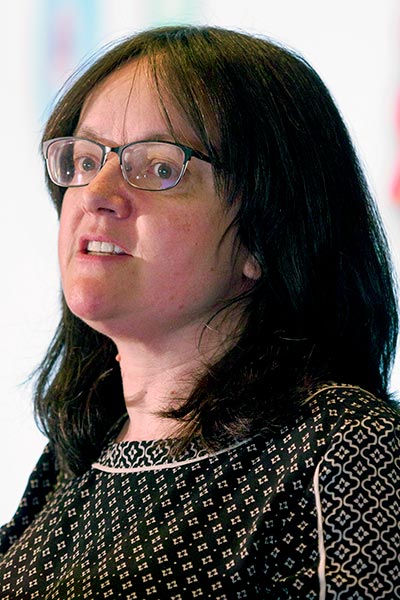Major themes and takeaways from Annual Meeting 2024 highlighted in final plenary session
//
Estimated Read Time:
The American Association for Cancer Research (AACR) Annual Meeting 2024 wrapped up six days of presentations on Wednesday, April 10, with a fast-paced review of major themes and takeaways from the program and a glimpse into the future of the field.
The closing plenary session, AACR Annual Meeting 2024 Highlights: Vision for the Future, featured three speakers focusing on the areas of basic cancer science and translational research; prevention, early detection, population sciences, and disparities research; and clinical research and clinical trials. The full session is available on demand for registered Annual Meeting attendees through July 10, 2024, on the virtual meeting platform.
Basic cancer science and translational research
Cancer is more complex than basic researchers imagined at the turn of the century. What was a story of mutations enabling tumor cells to evade antitumor signaling, invade new tissues, and metastasize has become an interactive picture involving the tumor microenvironment, host macroenvironment, and a multitude of external factors.

“We should embrace the complexity,” advised Mikala Egeblad, PhD, Bloomberg Distinguished Professor of Tumor Microenvironment at Johns Hopkins University. “I think the systemic influences of cancer are important … it’s a whole-body disease, and it’s even affected by the environment.”
Another take-home message from Annual Meeting sessions, Egeblad said, is that basic science continues to identify new types of targets and new drugs. Numerous advances in cancer chemistry, including the application of activity-based protein profiling, are changing the paradigm for what are considered undruggable targets for cancer therapy.
Sessions also demonstrated the need for a multidimensional understanding of cancer, she said. Multi-omics approaches that map tumors in two and three dimensions are providing new information on spatial interactions between tumor cells, immune cells, bacterial cells, and the rest of the microenvironment, while even more insight can be gained by looking at a fourth dimension: time. Computational biology and artificial intelligence (AI) are powerful tools and should be increasingly helpful to make sense of all this data, Egeblad said.
Prevention, early detection, population sciences, and disparities research

Presentations at the Annual Meeting showed that while AI is a powerful tool that can potentially help improve disparities in cancer research, care, and outcomes, there are currently significant limitations. AI may introduce inaccuracies via so-called hallucinations, and the data used to train these tools are often not representative of diverse populations. Acknowledging these limitations is essential for equitable scientific research, cautioned Melissa A. Simon, MD, MPH, George H. Gardner Professor of Clinical Gynecology at Northwestern University Feinberg School of Medicine.
Sessions explored emerging approaches to early cancer detection, and Simon highlighted the importance of optimizing trade-offs in cancer screening. Useful screening is not just a question of translating new biological or technological knowledge into new tests, she said, but also recognizing the benefits and harms in who is tested and how often—accounting for overdiagnosis, affordability, and accessibility—as well as what happens after a positive test.
The interplay of genetics, social factors, and environmental exposures on cancer, as detailed throughout the Annual Meeting, emphasizes the need to include diverse individuals in clinical trials, Simon said. It is also critical to continue to create opportunities for cancer researchers of different identities, as well as to cultivate effective communication and relationships with the public.
“You have to really understand the different identities of the populations with which you are trying to mitigate disparities and move forward with eliminating cancer, ultimately,” she said.
Clinical research and clinical trials
Trials reported at the Annual Meeting 2024 documented important improvements in targeted therapies, immune and cellular therapies, and cancer vaccines.

“This is actually an incredibly exciting time in clinical oncology,” said Ryan B. Corcoran, MD, PhD, Mark J. Kusek Endowed Chair in Colorectal Cancer and associate professor of medicine at Harvard Medical School, and director of the Tucker Gosnell Center for Gastrointestinal Cancers at Massachusetts General Hospital Cancer Center. “I think we are seeing what the mission of the AACR is, which is harnessing and leveraging the phenomenal scientific advances that have happened in the last year and translating them into approaches that are truly impacting the lives of cancer patients.”
Targeted therapies showed promise at the Annual Meeting. New roles and strategies for PARP inhibition were on display in results from the PARTNER trials of neoadjuvant olaparib in germline BRCA-mutated breast cancer and triple negative breast cancer, as well as the PETRA study evaluating the first-in-class PARP1 inhibitor saruparib, which is more selective than currently available nonselective PARP inhibitors. Researchers also presented results on the direct targeting of RAS mutations in KRAS and NRAS mutant cancers, as well as findings on the favorable efficacy of antibody drug conjugates alone or in combination with immune checkpoint inhibitors (ICIs).
The Annual Meeting also featured results on immune and cellular therapies, including ICI combinations such as copanlisib plus nivolumab in microsatellite-stable colorectal cancer and pembrolizumab plus olaparib in metastatic squamous non-small cell lung cancer. In addition, there was encouraging evidence that patients with advanced clear cell renal cell carcinoma may benefit from a new allogeneic CAR T-cell therapy.
Finally, results from multiple high-quality cancer vaccine trials were reported at the Annual Meeting. Corcoran highlighted findings on a personalized RNA vaccine for pancreatic cancer, which he said suggests that researchers may be starting to move the needle on effective cancer vaccines.




